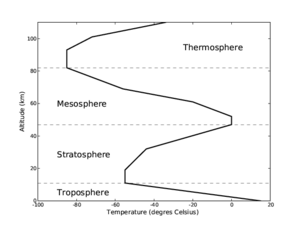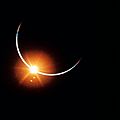Atmosphere of Earth facts for kids
The atmosphere is the layer of gases that surrounds our Earth. It stays around our planet because of Earth's gravity. It's mostly made up of nitrogen (about 78%) and lots of oxygen (about 21%). There are also small amounts of other gases like argon, carbon dioxide, and water vapor.
The atmosphere is super important for life on Earth! It protects us by absorbing harmful ultraviolet rays from the sun. It also helps keep our days from getting too hot and our nights from getting too cold.
Tiny solid bits, like ash, dust, and volcanic ash, are also part of the atmosphere. These tiny bits are important for making clouds and fog.
The atmosphere doesn't just stop suddenly. The higher you go above Earth, the thinner the air gets. There isn't a clear line where the atmosphere ends and outer space begins. However, some people use the Kármán line as a kind of border. Most of the atmosphere (about 75%) is within 11 kilometres (6.8 miles) of Earth's surface.
Contents
How Earth's Atmosphere Changed
Long, long ago, Earth's atmosphere was very different. It had almost no oxygen!
Early Earth's Atmosphere
When Earth first formed, its atmosphere was mostly hydrogen. It might have also had gases like water vapor, methane, and ammonia, similar to what's found on gas giants like Jupiter and Saturn.
Carbon Dioxide and Nitrogen Era
Over time, the atmosphere changed. Lighter gases like hydrogen and helium floated away into space because Earth's gravity couldn't hold them. The atmosphere then became mostly carbon dioxide and nitrogen. For a very long time (billions of years!), carbon dioxide was the main gas.
The Great Oxygen Change
About 2.4 billion years ago, something amazing happened called the Great Oxygenation Event. Tiny living things called cyanobacteria started making free oxygen through a process called photosynthesis. This slowly changed the atmosphere to what we have today, with lots of oxygen. Most living things now need oxygen to breathe, but some special anaerobic organisms can live without it.
Layers of the Atmosphere
The atmosphere is like a giant onion with different layers. Each layer has its own special features, especially how the temperature changes as you go higher.
Here are the main layers, starting from the ground up:
Troposphere: Where Weather Happens
- This is the layer closest to Earth's surface.
- It goes up to about 0 to 18 kilometres (0 to 11 miles) high.
- In this layer, the higher you go, the colder it gets.
- All the Weather we experience, like rain, snow, and wind, happens here.
Stratosphere: Stable Air for Planes
- This layer starts where the troposphere ends, around 18 kilometres (11 miles).
- It goes up to about 50 kilometres (31 miles).
- Unlike the troposphere, the higher you go in the stratosphere, the hotter it gets! This heat comes from the Ozone layer at the top, which absorbs sunlight.
- There's not much water vapor here. Airplanes often fly in this layer because it's very stable and has less air resistance.
Mesosphere: The Middle Layer
- This layer starts at 50 kilometres (31 miles).
- It ends around 80 or 85 kilometres (50 or 53 miles).
- Again, the higher you go, the colder it gets in this layer.
- Strong Winds here make the temperature a bit unstable.
Thermosphere: Radio Waves and Heat
- This layer begins at 80 or 85 kilometres (50 or 53 miles).
- It can go up to 640 kilometres (400 miles) or even higher!
- In the thermosphere, the higher you go, the hotter it gets again.
- This layer is very important for radio communication because it can reflect some radio waves back to Earth.
Exosphere: Fading into Space
- This is the very top layer, above the thermosphere.
- It gradually fades into interplanetary space, where Earth's atmosphere mixes with the vacuum of space.
Atmospheric Boundaries
The places where one layer changes to the next are called "-pauses."
- The tropopause is where the troposphere ends (about 7 to 14 kilometres (4.3 to 8.7 miles) high).
- The stratopause is at the end of the stratosphere.
- The mesopause is at the end of the mesosphere.
These are like invisible boundaries between the layers.
The average temperature of the atmosphere right at Earth's surface is about 14 °C (57 °F).
Air Pressure
The atmosphere has pressure. This is because even though air is a gas, it still has weight! The average atmospheric pressure at sea level is about 101.4 kilopascals (14.71 psi). This pressure pushes down on everything.
Air Density and Mass
The density of air at sea level is about 1.2 kilograms per cubic meter. This means a cubic meter of air weighs about 1.2 kilograms. As you go higher up, the air becomes less dense, just like the pressure drops.
The total mass of the entire atmosphere is about 5.1 × 1018 kg. This sounds like a lot, but it's actually a very tiny part of Earth's total mass.
Related pages
Images for kids
-
Blue light is scattered more than other wavelengths by the gases in the atmosphere, surrounding Earth in a visibly blue layer when seen from space on board the ISS at an altitude of 335 km (208 mi).
-
Space Shuttle Endeavour orbiting in the thermosphere. Because of the angle of the photo, it appears to straddle the stratosphere and mesosphere that actually lie more than 250 km (160 mi) below. The orange layer is the troposphere, which gives way to the whitish stratosphere and then the blue mesosphere.
-
Temperature trends in two thick layers of the atmosphere as measured between January 1979 and December 2005 by microwave sounding units and advanced microwave sounding units on NOAA weather satellites. The instruments record microwaves emitted from oxygen molecules in the atmosphere. Source:
-
Earth's atmosphere backlit by the Sun in an eclipse observed from deep space onboard Apollo 12 in 1969.
See also
 In Spanish: Atmósfera terrestre para niños
In Spanish: Atmósfera terrestre para niños












